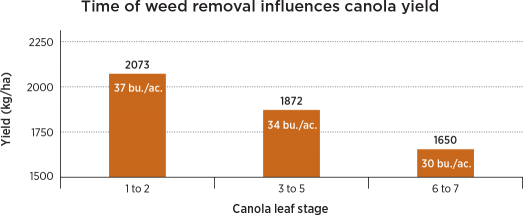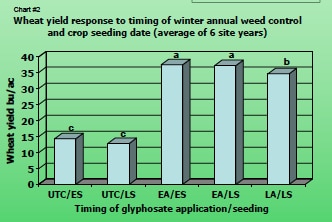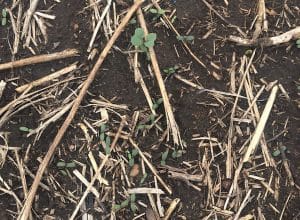Early in-crop weed control will yield more than late control almost all the time. Early-emerging weeds tie up nutrients and moisture valuable to the crop. They also out-compete the crop for sunlight if their leaves cover canola seedlings.

Early spraying can include pre-seed burnoff and in-crop spray at the cotelydon to two-leaf stage of the crop. Earliest timing depends on the specific herbicide system.
Early spraying costs the same as late spraying. Early spraying may actually cost less because it often provides control at lower rates. (Note: If the crop is slow to establish ground cover, a second application may be required. But that doesn’t take away from the value of early spraying.) Early weed control is the economic winner.
One exception would be if dry conditions have slowed all plant growth – crop and weeds. You want weeds actively growing in order for herbicide uptake and efficacy.
This article has four sections:
- Studies behind this early-spraying recommendation
- How early is too early?
- How late is too late?
- Weed scouting tips
Studies behind this early-spraying recommendation
1. Up to 35 per cent yield loss. Charles Geddes and Breanne Tidemann, Agriculture and Agri-Food Canada (AAFC) research scientists, led a meta-analysis of 89 weed studies in canola from 2003 to 2020. Studies were from Alberta, Saskatchewan, Manitoba and North Dakota. The report cites previous work showing that potential yield loss from weeds is similar to that of all other pests (insects and diseases) combined. Geddes and Tidemann conclude that canola yield loss due to weed interference averaged 30 per cent across the Canadian Prairies, weighted based on canola acres. Specifically, it was 35 per cent in Alberta, 30 per cent in Saskatchewan, 18 per cent in Manitoba and 28 per cent in North Dakota. This demonstrates the total potential yield loss from weeds. While this study did not include time of weed removal, other studies below show that earlier is better.
2. One weed early = 100 weeds late. AAFC summarized nine site-years of spray timings of Roundup Ready canola at Lacombe, Beaverlodge and Edmonton, Alberta. Researchers applied glyphosate at three crop stages – 1- to 2-leaf, 3- to 4-leaf and 5- to 6-leaf. In seven out of nine cases, early timings (1- to 4-leaf stage) resulted in the highest canola yields. At Lacombe and at Edmonton sites in 1999, the latest applications yielded better because a significant number of weeds emerged after the early and mid glyphosate application. A second glyphosate application would be the strategy at those two sites. The report showed an advantage of 3 bu./ac. for controlling weeds at the 1- to 2-leaf stage of canola versus 3- to 4-leaf stage, and a 7 bu./ac. advantage for 1- to 2-leaf versus 6- to 7-leaf. See Table 1 for details.

3. Delaying control to the 6 to 7-leaf stage can reduce yields by 20%. A Field-scale time of weed removal in canola study was conducted at 10 western Canada canola fields in 1999 and 2000 by Harker, O’Donovan, Clayton and Mayko. Sites in 1999 were established at Rolla, B.C., Vegreville and Wanham, Alberta, Delmas and Naicam, Saskatchewan, Carman and Russell, Manitoba and sites in 2000 were established at Vegreville, Alberta; Naicam, Saskatchewan; and Selkirk, Manitoba. It was concluded that canola growers are well advised to ensure weed removal at relatively early growth stages. Delaying weed removal until the 6- to 7-leaf stage reduced canola yields in this study by 20 percent. The lead scientists also estimated that yield loss from one weed emerging a week before the crop is equivalent to 100 weeds emerging three weeks after the crop. See Graph 1 for details.
4. Without weed control, other inputs don’t matter (much). Another AAFC canola study found that weed control was more important than any other major input. A summary in the Canola Digest Science Edition of 2013 reads: “In a barley-canola rotation, the primary input that influenced yield was weed control. Without weed control, the addition of genetics, a higher seeding rate and nitrogen fertilizer had no impact on net return.”
5. Don’t wait for late flushes. Applied research associations in Alberta ran farm field trials showing that waiting for late weeds to germinate did not pay. Their results showed a 224 kg/ha (4 bu./ac.) yield increase by spraying at the 1-leaf versus the 5-leaf stage.
6. 10% yield loss. University of Manitoba researchers ran trials at multiple locations in 1998 and 1999. They concluded that weed control after the 4-leaf stage can lead to yield loss greater than 10 per cent. The study.
7. Early best at 24 of 27 site years. The Canola Council of Canada ran weed removal timing trials across Western Canada in 1998, 1999, 2000 at Crop Production Centres. Large plots were sprayed for weeds at the 1 to 2-leaf stage of the crop (early), the 3 to 5-leaf stage (mid) and at the 6 plus leaf stage (late). In some years, the mid timing was missed or not included in the trials. In some years, two broader timings were used as opposed to three narrower timings. At 24 out of 27 site years, the earliest timing gave the best yield. The early applications showed a 16 per cent yield advantage compared to the latest timing. See Table 2 for details.

8. Spray early, even if seeding late. Ken Sapsford and Rick Holm, University of Saskatchewan researchers, found that early weed control is more beneficial than early seeding. This is true even if farms won’t be seeding for a couple of weeks. While this particular study was done on wheat, Sapsford says results would be similar for canola. Winter annuals like flixweed, shepherd’s purse, narrow-leaved hawk’s-beard and stinkweed grow early and can remove a lot of soil moisture. Early weed control stops this uptake, preserving moisture and nutrients for the crop. Read the study poster. The study compared three treatments: (1) Glyphosate the first week of May followed by seeding the first week of May. (2) Glyphosate the first week of May and seeding the fourth week of May. (3) Glyphosate the fourth week of May followed by seeding the fourth week of May. “The first two treatments yielded similarly, whereas the burnoff done just before the later seeding date had a reduction in yield compared to the other two,” says Clark Brenzil, Saskatchewan’s provincial weed control specialist. His recommendation: “Your sprayer can travel a lot better on fields that aren’t suitable for seeding, so get the pre-seed burnoff done early over all your fields and then start seeding.” See Graph 2 for details.
9. Grower survey analysis connects early spray with higher yield. AAFC’s Elwin Smith analyzed results from the 2011 CCC grower survey. Smith showed that growers spraying at the 1- or 2-leaf canola stages had higher yields than growers going earlier or later with their first in-crop herbicide application. See Figure 2 here.
10. Crops “see” weeds. Clarence Swanton found that light reflected from neighbouring weeds will induce a “shade avoidance response” in soybeans. This leads to increased variability in yields. Swanton, a University of Guelph researcher, published the study in Weed Research in 2016. He concluded that the soybean crop – as soon as it “sees” the weeds – will alter its growing pattern. It puts less energy into roots and more energy into a taller stem. Swanton says, “I do think that this response could apply to canola but needs to be tested.”
The clear message here is that even if a later application can remove all the weeds, the yield loss from that early competition cannot be recovered.
How early is too early?
A CCC agronomy specialist encountered the situation in the photo above with the tiny weeds. Canola emergence was patchy in this small area, but generally good overall. The agronomy specialist wondered if these buckwheat seedlings, though very abundant, were too small to spray? The answer is no. Broadleaf weeds sprayed at the cotyledon stage with canola herbicides (Liberty, Roundup and the Clearfield products) should be well controlled. The key is to have coverage. Large droplets and low water volumes could mean some small weeds do not get a spray droplet. When using coarse sprays, recommended to reduce drift, also use higher water volumes to improve coverage.
Grassy weeds such as wild oats may not be controlled as well at the coleoptile stage because the largely inert coleoptile will protect the true leaves from exposure to the herbicide. The other challenge is that wild oats’ natural leaf surface, which is hard to wet, makes deposition of a herbicide on the leaf surface difficult. (See page 107 here.) If the only weeds are grassy weeds, wait until the earliest (and most costly) ones are at the 2- to 3-leaf stage. With both broadleaf and grassy weeds present, apply early to control the broadleaf weeds. If necessary, spray again to control the grassy weeds, and use a grassy weed herbicide alone or in a tank mix with the HT partner product.
How late is too late?

With any later applications, always follow labels for rate, timing and pre-harvest intervals (PHI). Applications made after the label window can lead to reduced weed control due to advanced weed staging and reduced herbicide contact with the weeds through the increased canola canopy closure. Late applications can also cause canola buds to abort, increasing the potential for permanent yield loss. Finally, late applications and higher than recommended rates of registered herbicides can increase the risk of elevated residues in the marketable grain. Read Late window applications of herbicide.
Weed scouting tips
Thorough scouting for weeds is essential in making informed herbicide decisions. Weeds that occur along the field margin or near the approach may not occur throughout the majority of the field. Similarly, the most economically threatening weed(s) may not be present or in great number in easy-to-scout areas of the field. Scouting should be done across the entire field to get an accurate feel for the distribution, staging and species of weeds present. Check a minimum of 20 one-square-metre areas per field. Identify the weed species present and how big they are. This will help choose the right product and rate. Tables for pre-seed and in-crop options based on target weeds.
Also consider the crop stand and its competitiveness. With a thinner stand, the necessity of a second in-crop application increases because canopy cover will be achieved that much later.
Waiting for more weeds to emerge rarely pays off because it means these early larger weeds have that much more time to get established, making them more difficult to control at in-crop rates. However, if weeds are few and far between — perhaps due to an effective pre-seed burnoff — waiting to spray is fine.
Scout after herbicide application to check efficacy, check for escapes and for later flushes.
More…
- Pre-seed burnoff: Tip for best results
- Integrated weed management: Best practices
- Spraying tips for tough conditions
- In-crop herbicide timing – Scenarios
- Tips for grassy weed control in canola
- Weed control strategies for each HT system
- How to identify a spray contamination issue
- Sprayer tank clean out tips
- Avoid spraying during an inversion
- Characterizing turbulent spray deposition from self-propelled sprayers

